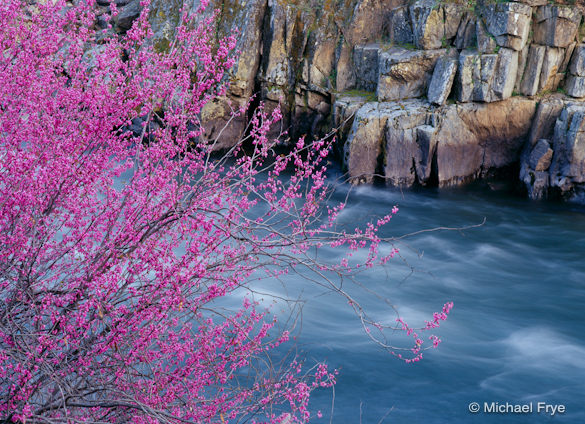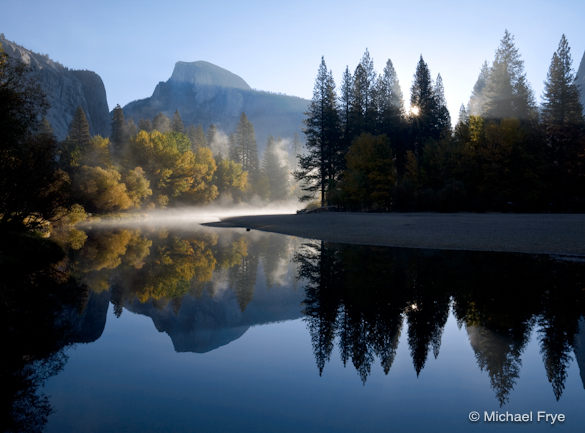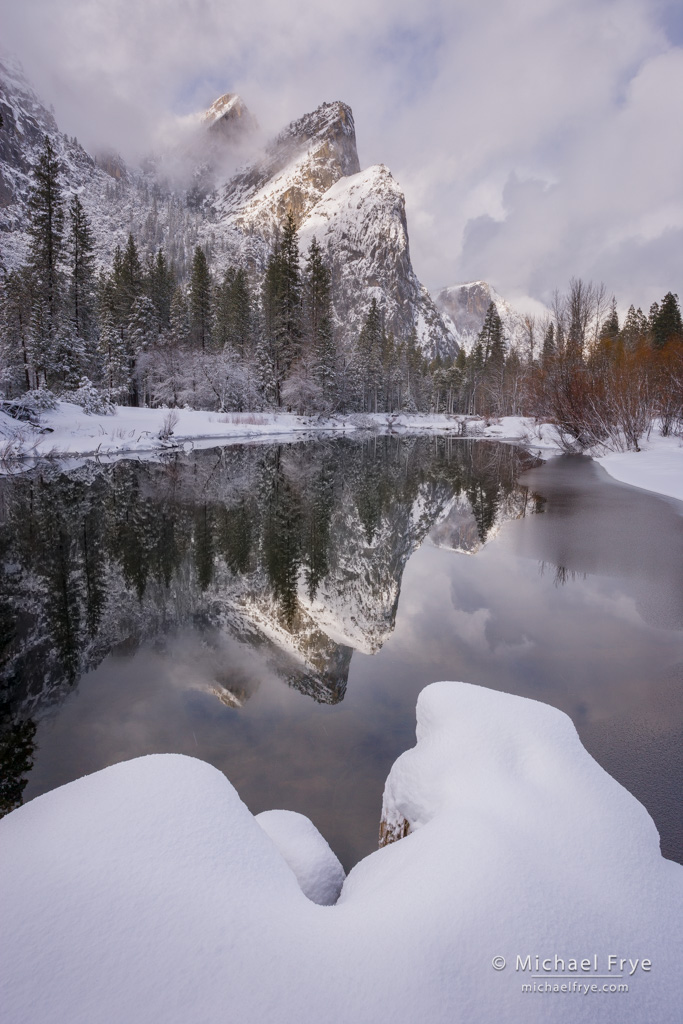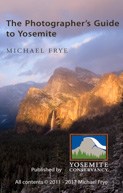by Michael Frye | Apr 5, 2011 | Yosemite Photo Conditions
 Redbud and Rocks along the Merced River. Soft light emphasized the colors.
Redbud and Rocks along the Merced River. Soft light emphasized the colors.
Flower Reports
They’re late this year, but the redbud are finally blooming in the Merced River Canyon, along Highway 140 west of Yosemite. I’d say they’re just short of peak; some have not yet bloomed, but none have leaves. Photographically, this is the most interesting time, as once they start to leaf out they’re not as photogenic.
The big snowstorm two weeks ago damaged some of the redbud near El Portal, but further west they’re in great shape. Look for them everywhere near the river along the main highway, as well as the Merced River Recreation Area at Briceburg.
So far few poppies have appeared near the Merced River. They might be late, or it just may turn out to be a poor year for them—time will tell. But the best poppy blooms I’ve seen here have always occurred in March.
(more…)
by Michael Frye | Mar 27, 2011 | Announcements, Photography Tips
 Autumn Sunrise, Half Dome and the Merced River
Autumn Sunrise, Half Dome and the Merced River
How do you give your photographs impact? How do you convey the grandeur of the landscape in a small, two-dimensional image? You have to find your focus. I’m not talking about turning the ring on your lens—I’m talking about focusing your composition on the essentials and finding a strong design.
My latest article in Outdoor Photographer magazine discusses exactly how to do that. Titled Find Your Focus, it shows you how to communicate your vision by simplifying, finding focal points, creating depth, and looking for patterns. The article is scheduled for the May issue, due out next month, but it’s already on the OutdoorPhotographer.com website—a sneak preview. I hope you enjoy the article!
by Michael Frye | Mar 23, 2011 | Yosemite Photo Conditions

A snowy scene from 2008
A storm dumped three feet of snow in Yosemite Valley on Sunday and Monday, knocking down trees and power lines, and closing all roads into the park. Due to lack of electricity and water in Yosemite Valley, the park service evacuated all visitors and non-essential employees. The park won’t reopen until power is restored, which may not be until this weekend, or possibly later. The main electrical line into the park was cut by a rock slide that knocked over an electrical tower, and replacing the tower requires bringing in crews and equipment by helicopter.
More rain and snow are falling in the park today, another storm is expected to arrive tomorrow, and one more on Saturday. These additional weather systems may hamper efforts to clear roads and restore electricity.
Power is still out in many foothill communities outside the park, especially around Oakhurst. We lost electricity at our home in Mariposa for about eight hours on Monday, but this was a small problem compared to what some of our neighbors are dealing with. My mom, who lives outside of Oakhurst, is still without power, so she’d taken refuge with us.
Here’s a link to one story and video about this event, and here’s another, both from Fresno’s ABC30 web site. If any of you find links to other good information, please post them in the comments. If you’re planning to head to Yosemite, call 209-372-0200 for the latest road information.
(more…)
by Michael Frye | Mar 21, 2011 | Reviews

When I think about contemporary landscape photographers who’s work I admire and respect, Guy Tal is definitely on that list. He consistently produces beautiful work in a natural style that reflects his appreciation for the natural world.
I recently had the opportunity to review Guy’s eBook, Creative Landscape Photography. I’ve read a lot of books and articles about photography, and written a few myself, so it’s refreshing when I find something that presents a new idea, or a new way of looking at the process of photography. This book does that. Guy has the ability to get you to think in different ways about photography, and about your own approach to a subject. Rather than presenting recipes for successful photographs, or abstract philosophical ideas, he gives you concrete steps to help provoke your own thought process, and stimulate your creativity.
This includes a list of questions to ask yourself before photographing a subject, like, “What element(s) do I find most visually appealing about the scene?, or “What emotion(s) can I convey to my viewers using the elements in this scene?” All vital questions.. While highly-experienced photographers may consider such things instinctively and automatically, even they can use a reminder, and less experienced photographers will find that a conscious effort to answer these questions will pay big dividends.
Guy has always struck me as a thoughtful person, and that comes through in this volume. It’s clear that he’s has given a lot of thought to every aspect of landscape photography:
“A common enemy of good composition is the impulse when an attractive scene presents itself to immediately reach for the camera, snap a few quick exposures, and move on to continue the hunt. In reality, chances are your perspective will not be ideal at the precise moment you discover your subject.”
“Consider all the rules, take what works. Apply where appropriate, but do not be afraid to break every last one of them. Go with your instinct. Photograph for yourself and satisfy your own sensibilities and aesthetics. True artists do not pander to a pre-selected audience. Instead, they carve an audience of their own from those who will encounter and be moved by their work.”
The heart of the book is the first four sections, called The Creative Process, Concept, Visualization, and Composition. The remaining three parts—Capture, Processing, and Presentation—support the ideas presented in the beginning, explaining how to carry your original vision through to a finished photograph. The book also includes many of Guy’s beautiful photographs to inspire you, most from one of my favorite regions in the country, the canyons of southern Utah.
Anyone who’s serious about making better, more creative landscape photographs will learn a lot from this eBook. It’s available directly from Guy Tal’s web site for 9.95. He’s also announced a sequel,Creative Processing Techniques in Nature Photography, due out later this year.
by Michael Frye | Feb 25, 2011 | Critiques

“Another Lousy Sunset” by Ken Hornbrook
The critique is finally here—thanks for your patience!
Light
This week’s photograph was made by Ken Hornbrook at Bandon Beach along the Oregon coast. There’s some wonderful sunset color in the sky, plus blue and orange reflections in the water, creating great color contrasts throughout much of the frame. Any photographer standing at this beach that evening would be excited about the possibilities. But what do you do with that light, that color?
Composition
Ken found a great camera position to take advantage of the colorful sunset and interesting shapes of the rocks. It looks like he moved into a small cove or gap between cliffs or sea stacks. This created a nice window, with dark shapes on the sides framing the view of the stacks beyond. The curving, colorful V-shape of the water in the foreground leads our eyes smoothly from bottom to top. It even has a bit of an S-curve. I’ve pointed out problems with foregrounds in previous critiques, but I think this one really works, and adds a lot to the photograph.
(more…)













